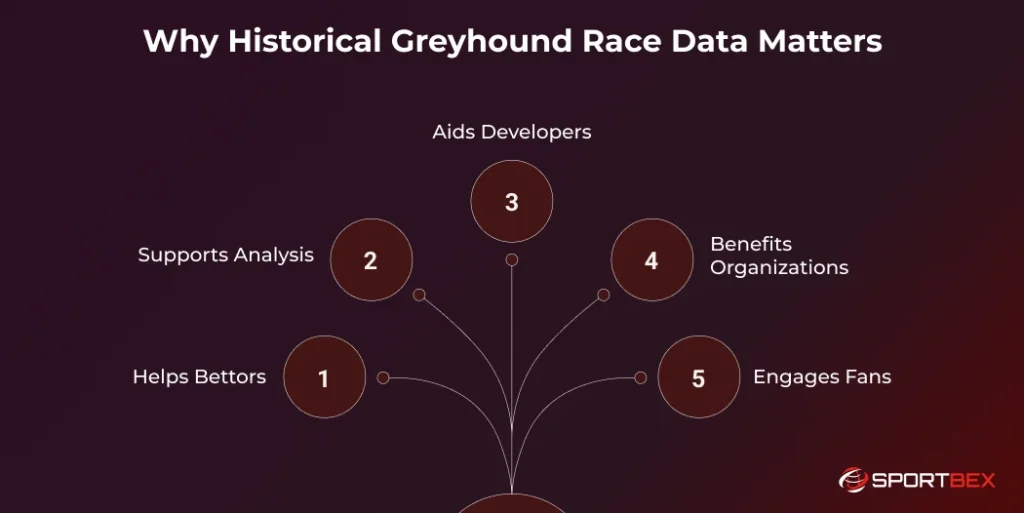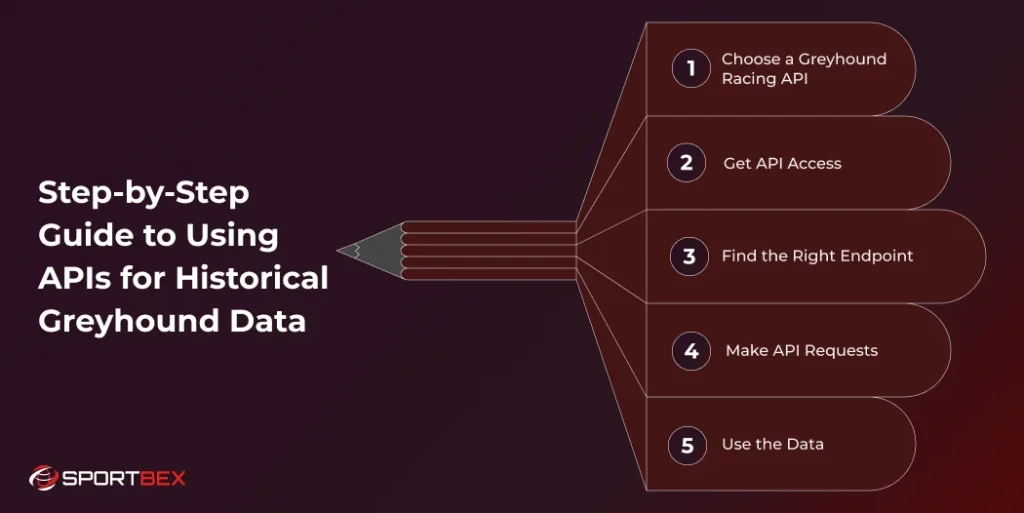Greyhound racing is a fast-paced and exciting sport that has been loved for decades. Fans, bettors, and developers all want to understand how greyhounds perform over time.
That’s where greyhound historical data comes in. By looking at past greyhound race results and performance stats, you can spot trends, compare greyhounds, and make smarter decisions.
In the past, collecting this information meant hours of manual research. Today, with greyhound racing data available through APIs, getting accurate and detailed insights has become much easier.
You can access past greyhound race results, track individual greyhound performance, or even integrate this data into apps, dashboards, and betting platforms.
In this guide, we will explain what historical greyhound race result is, why it’s important, and how to access it step by step using APIs. We’ll also help you choose the right Greyhound API provider so you always get reliable data.
What Is Historical Greyhound Race Data?
Historical greyhound race data refers to detailed information about past greyhound races. It’s a digital record of how each race unfolded—covering greyhound race results, greyhound names, finishing times, odds, track details, and more.
Developers, analysts, and bettors often use this data to study performance patterns, track consistency, and predict future outcomes. For instance, by analyzing how a dog performed under certain weather or on specific greyhound racing tracks, one can identify strengths, weaknesses, or tendencies.
Types of Information Included
Historical greyhound racing data usually includes:
- Race date, time, and location
- Greyhound names and their trap numbers
- Finishing positions and greyhound race result
- Starting prices and greyhound racing odds
- Track conditions (dry, wet, fast, slow)
- Split times and sectional results
- Trainer and owner details
- Box numbers and margins
Many Greyhound Data APIs also include visual elements like track maps or video links for live greyhound racing results, allowing users to connect past performance to present events.
How APIs Make It Accessible
In the past, if you wanted greyhound historical data, you had to search through old records or spend hours looking through greyhound race results. APIs have made this process fast and efficient.
By using a Greyhound API, you can send a request and get structured data back in seconds. For example, you can access results for a specific date, track, or greyhound name without browsing multiple websites.
Most APIs allow users to:
- Retrieve race results and statistics
- Filter by track, date, or dog
- Export data in JSON or XML formats
- Access both historical and live results
This easy access is what makes APIs powerful tools for anyone serious about understanding or using greyhound race performance data efficiently.
Why Historical Greyhound Race Data Matters

Helps Bettors
If you’re betting on greyhound races, knowing how a greyhound has performed in the past can really help. Greyhound historical data shows you previous greyhound race results, so you can spot patterns and see which greyhounds do well under certain conditions. This way, you can make smarter bets instead of just guessing.
Looking at past performance also helps you understand how a greyhound handles different tracks or distances. Some greyhounds may perform better in specific conditions, and knowing this can give you an edge when planning your bets.
Supports Analysis
For analysts, past race information is extremely useful. By comparing live greyhound racing results with historical performance, they can see trends over time, like which greyhounds are improving and which may be slowing down.
Historical data also helps spot patterns that aren’t obvious from just one or two races. For example, analysts can see which tracks favor certain greyhounds or how a dog performs over longer distances. This kind of insight is invaluable for predicting future results.
Aids Developers
Developers can use historical data to make apps and dashboards much more useful. With a Greyhound Data API or Greyhound Betting API, they can show past greyhound race results, performance stats, and trends without manually collecting information.
This allows apps to be interactive and informative. Users can check past performances, compare greyhounds, and even track trends over time, making the experience more engaging for fans and bettors.
Benefits Organizations
Racing clubs, media platforms, and other organizations use historical data to create reports, articles, and content that keeps fans informed. Accurate greyhound race data helps highlight top performances, compare past results, and tell stories that fans enjoy.
This also ensures reliability. With verified historical data, organizations can confidently provide stats and analysis, making their coverage trustworthy and engaging. It’s a great way to keep fans connected to the sport.
Engages Fans
Fans love following their favorite greyhounds and seeing how they’ve done in past races. Historical data allows them to track winning streaks, compare performances, and understand the bigger story behind each race.
Having access to greyhound race performance data makes the sport more exciting. Fans can see improvement over time, celebrate achievements, and get more invested in each race, making the experience richer and more enjoyable.
Step-by-Step Guide to Using APIs for Historical Greyhound Data

Getting historical greyhound race data is much easier now. In the past, people had to spend hours searching through old race reports and spreadsheets.
Today, a Greyhound Data API makes it quick and simple. Whether you’re a bettor, analyst, or developer, APIs give you the ability to track greyhound performance, compare results, and make smarter decisions almost instantly. Here’s a straightforward guide to help you get started.
Step 1: Choose a Greyhound Racing API
The first step is picking an API that you can rely on. Look for one that covers multiple greyhound racing tracks, provides historical race results, and includes performance metrics for individual greyhounds. Providers like Greyhound Data API are popular because they combine past race data, live updates, and greyhound betting odds in one place.
Key things to check:
- Coverage: Make sure the API has a wide range of historical races across different tracks.
- Accuracy: The data should be verified and updated regularly.
- Features: Check if it provides race results, trainer info, and betting odds.
Choosing the right provider saves you time and ensures you are working with reliable data for your apps, analysis, or betting tools.
Greyhound Racing Data, Made Simple
Easily add live race results and dog profiles to your website or project.
Step 2: Get API Access
Once you’ve picked a provider, the next step is to register and get your API key. This key is like a password that gives you secure access to the data. Most providers also offer guides or documentation to help you understand how to make requests and read the results.
Tips for beginners:
- Keep your API key safe and don’t share it.
- Be mindful of request limits so you don’t accidentally exceed them.
- Read the documentation carefully to understand what endpoints are available.
With your API key, you can start fetching greyhound historical data and explore past race results with ease.
Step 3: Find the Right Endpoint
APIs usually have different endpoints for different types of data. To get Historical greyhound race results, you need to use the endpoint specifically made for greyhound race results. Depending on what you want, you can filter by track, date, distance, or even trainer.
What to look for:
- Individual greyhound history or track-specific race data.
- Filters for distance, track condition, or race type.
- Formats like JSON or XML, which are easy to use in apps and dashboards.
Using the right endpoint ensures you get the exact data you need, making your analysis faster and more accurate.
Step 4: Make API Requests
Once you know the endpoint, you can send requests to the API. Add parameters like track name, race date, or greyhound name, and the API will return structured greyhound race performance data ready to use.
Helpful tips:
- Test your requests first to make sure the results are what you need.
- Use filters to narrow down large datasets.
- Handle errors properly to prevent problems in your apps or dashboards.
APIs save you the hassle of manually searching for results. You can access historical race data instantly, track trends, and compare performances without the stress of collecting data yourself.
Step 5: Use the Data
After you receive the data, it’s ready to use. You can display greyhound race results on a website or app, analyze trends over time, or use it to support betting decisions. APIs make it easy to combine historical data with live greyhound racing results for a complete view of performance.
Ideas for use:
- Build interactive dashboards to follow top-performing greyhounds.
- Compare past and current results to spot improvements.
- Share insights with fans to keep them engaged and informed.
Using historical data properly adds value for bettors, developers, and fans alike, making the sport more enjoyable and informative.
Choosing the Right Greyhound API Provider
Selecting a reliable API provider ensures accurate and up-to-date greyhound race results. Look for coverage across multiple tracks, clear documentation, and smooth integration.
Extra features like odds, predictions, or detailed race history are nice but not as important as reliability. A dependable provider keeps your data current and your apps or dashboards running smoothly. Here’s what to consider:
- Coverage and Accuracy: Choose a provider that gives detailed greyhound race data for multiple tracks. Look for historical results and performance stats. Accurate data is key for analysis, apps, or betting.
- Ease of Use: A good API is easy to work with! You want one that has clear instructions and is simple to add to your project. It should play nicely with websites, apps, or dashboards and use common formats like JSON or XML.
- Compatibility: Make sure the API works with your platform and can provide both past and live greyhound racing results. This makes tracking and analyzing much simpler.
- Extra Features:Some APIs also give you betting odds, predictions, or detailed race histories. These are nice to have, but they’re not as important as getting reliable and accurate data.
- Reliability: Look for a provider that updates its data often and has a good reputation. When the data is dependable, your apps, dashboards, or analysis tools will work correctly every time.
Having access to a wider range of data from a single provider can save you a lot of time and effort.
Conclusion
Getting historical greyhound race results is important for anyone interested in greyhound racing, whether you’re a bettor, analyst, developer, or fan. With APIs, you can quickly access race results, track performance, and spot trends—no need to spend hours gathering data yourself.
A good Greyhound Data API gives you correct, complete, and up-to-date information. You can use it to build dashboards, connect with Greyhound Racing Tracks, or create betting tools with Greyhound Racing Odds.
With the tips in this guide, you’re ready to use greyhound race performance data. Whether you want to analyze races, build an app, or improve the fan experience, using historical data and APIs makes it simple to stay ahead in greyhound racing.
If you need reliable sports data, including for greyhound racing, pick a trusted Sports API provider. A good provider offers high-quality data, quick updates, and easy integration.
Live Data from Top Greyhound Tracks
Integrate the fastest, most reliable live odds and race data into your platform.
Frequently Asked Questions
A greyhound race result shows the outcome of a greyhound race, including finishing positions, times, trap numbers, and odds. Historical results help bettors, analysts, and fans track performance trends over time.
Knowing past greyhound race results allows bettors to make smarter decisions, analysts to identify trends, and developers to build apps or dashboards with accurate performance data.
You can access them easily using a Greyhound Data API. APIs provide structured greyhound race results, filterable by track, date, or dog, and can be integrated into apps, dashboards, or betting platforms.
Choose a provider with wide track coverage, accurate historical data, clear documentation, and timely updates. A reliable Greyhound Data API ensures you always get accurate greyhound race results.
Yes. Fans enjoy following top-performing greyhounds and comparing historical greyhound race results. Access to detailed results makes the sport more immersive and engaging.
Recent Blog
Top Benefits of Basketball Betting Odds for Betting Platform
December 12, 2025
 9 min
9 min
How to Use Greyhound Racing Data to Create Performance Insights
December 11, 2025
 9 min
9 min







